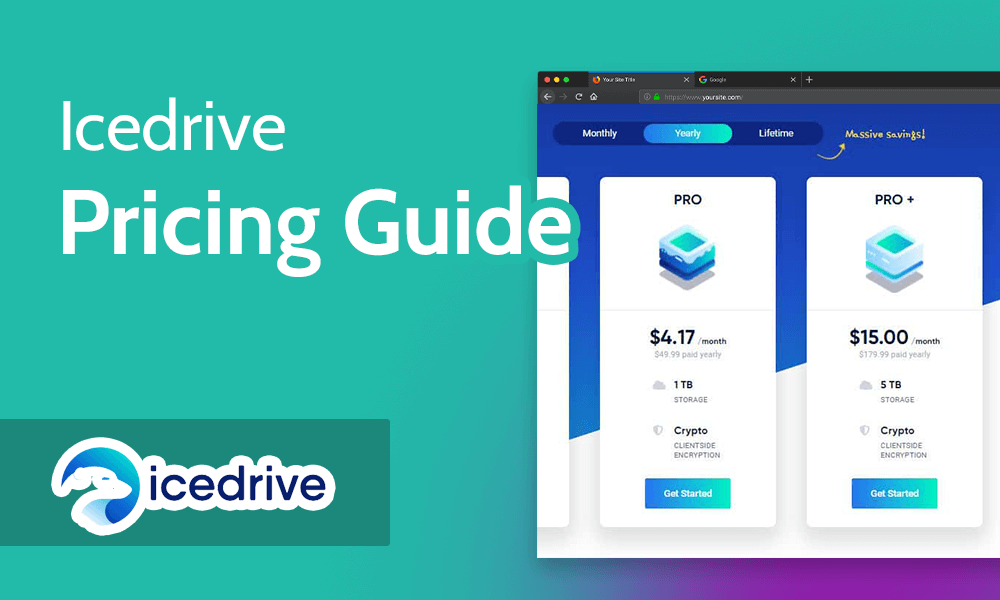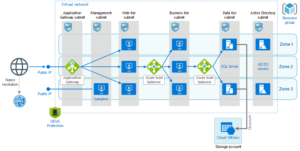
Icedrive stands out as one of the newer cloud storage providers. We list it as one of the best cloud services, and our Icedrive review highlights excellent features such as fast speeds, strong security and excellent privacy. If you’ve outgrown its free plan and are considering one of its paid storage plans, our Icedrive pricing guide will help you decide which one to choose.
Key Takeaways:
- Icedrive offers affordable subscriptions that make it easy to upgrade from its free 10GB cloud storage account.
- Icedrive has lifetime plans worth considering if you plan to stay with the service for many years.
- Comparable plans from Icedrive’s competitors offer more storage and higher prices, but maintain close per-GB costs.
Icedrive offers a free 10GB account, one of the better free cloud storage plans available. If you need more, they have several affordable options to meet most storage needs. Icedrive focuses on personal cloud storage services and does not offer business plans. Keep reading for all the details on Icedrive cost.
-
Icedrive’s Lite plan is the lowest-priced paid option. It has 150GB of storage for $19.99 per year, with no option for monthly payments. Icedrive’s Pro and Pro+ plans do have monthly payment options. The Pro plan has 1TB of storage for $4.99 per month or annually at $49.99. The Pro+ plan costs $17.99 per month or $179.99 annually for 5TB of storage.
-
Icedrive cloud storage is a newer service, but already has a positive reputation as a safe and secure cloud storage company. All accounts — even the free 10GB — enjoy data in-transit and client-side encryption features. However, only the encrypted folder has zero-knowledge encryption and that comes with the paid plans.
-
Icedrive and pCloud are two of the best cloud storage services on the market. Both offer excellent security and privacy. pCloud brings more features for sharing and collaboration, while Icedrive is easier to use and navigate.
-
No, even without using the zero-knowledge encrypted folder, Icedrive employees do not have access to your data. Using the encrypted folder, which is part of the paid plans, Icedrive will not have any access to your files.
Icedriveu2019s Lite plan is the lowest-priced paid option. It has 150GB of storage for $19.99 per year, with no option for monthly payments. Icedriveu2019s Pro and Pro+ plans do have monthly payment options. The Pro plan has 1TB of storage for $4.99 per month or annually at $49.99. The Pro+ plan costs $17.99 per month or $179.99 annually for 5TB of storage.n”}},{“@type”:”Question”,”name”:”Can I Trust Icedrive?”,”acceptedAnswer”:{“@type”:”Answer”,”text”:”
Icedrive cloud storage is a newer service, but already has a positive reputation as a safe and secure cloud storage company. All accounts — even the free 10GB — enjoy data in-transit and client-side encryption features. However, only the encrypted folder has zero-knowledge encryption and that comes with the paid plans.n”}},{“@type”:”Question”,”name”:”Is Icedrive Better Than pCloud?”,”acceptedAnswer”:{“@type”:”Answer”,”text”:”
Icedrive and pCloud are two of the best cloud storage services on the market. Both offer excellent security and privacy. pCloud brings more features for sharing and collaboration, while Icedrive is easier to use and navigate.n”}},{“@type”:”Question”,”name”:”Does Icedrive Scan Your Files?”,”acceptedAnswer”:{“@type”:”Answer”,”text”:”
No, even without using the zero-knowledge encrypted folder, Icedrive employees do not have access to your data. Using the encrypted folder, which is part of the paid plans, Icedrive will not have any access to your files.n”}}]}]]>
Icedrive Pricing Plans
Icedrive offers a free plan and three paid plans: Lite, Pro and Pro+. Upgrading from a free plan to any paid plan gives you access to the encrypted folder for sensitive data in your account. The files you place in that encrypted folder are zero-knowledge. This is the only extra feature you gain by upgrading. You’re paying more for storage, not a more robust service.
Icedrive’s lowest-priced option, the Lite plan, comes with 150GB of storage. You can only pay for this plan annually at $19.99, which averages $1.67 per month. However, Icedrive offers lifetime plans, which includes the Lite plan. More on that in the next section.
Icedrive’s offers affordable paid cloud storage plans.
Icedrive’s Pro plan increases the storage to 1TB for an annual cost of $49.99, which averages out to $4.17 per month. If you don’t want to pay for the entire year upfront, you can choose to pay monthly at $4.99.
The last option is the Pro+ plan, with 5TB of storage at $179.99 per year. This averages out to $15 per month. Paying monthly costs $17.99.
Icedrive Lifetime Plans
Icedrive offers lifetime cloud storage solutions similar to their monthly or annual plans. The primary benefit of a lifetime plan comes with longevity and the belief that a company will exist for many years. Icedrive is one of the newer cloud storage services on the market, so the risk may be slightly higher for some people when purchasing a lifetime plan.
Lifetime plans typically pay for themselves after a few years when compared to paying annually or monthly for the same plan over the same period of time. For example, Icedrive’s Lite plan has the same 150GB storage for a one-time price of $99. After five years, you’d pay more with the annual plan than the lifetime cost.
An Icedrive lifetime deal is worth the cost if you stay with the service.
Icedrive’s other two lifetime plans increase the storage capacity compared to the non-lifetime plans. The Pro III comes with 3TB of storage for a one-time payment of $499, while the Pro X has 10TB for $999. Neither of the lifetime pro plans equates to the annual options. However, the lifetime plans eventually pay for themselves.
Over a three-year period on the Pro plan, you’d pay a total of $150 when paying annually, or $179.64 paying each month. These amounts are nearly a quarter of the lifetime cost on the Pro III 3TB plan, for a third of the storage.
The same applies to the Pro X 10TB lifetime plan compared to the Pro + 5TB plan. It may take several years before the lifetime plans pay for themselves, but you get more storage than the annual plans in addition to the eventual payoff. If Icedrive is your long-term cloud storage, then it’s worth considering a lifetime plan.
Icedrive Value Comparison
Several of Icedrive’s competitors offer similar plans for your cloud storage needs. Our Sync.com review and our pCloud review detail these excellent services. Let’s take a look at how they compare.
Sync.com and pCloud both have 2TB plans, doubling Icedrive’s Pro plan at 1TB. Sync.com’s 2TB plan costs $96 annually, which averages $8 per month. pCloud’s 2TB plan costs $9.99 per month or $99.99 annually.
Monthly Price per TB, Annual Subscriptions
These plans offer similar value to Icedrive’s 1TB plan, which costs $4.17 per month when you pay annually. While it seems like Icedrive offers less storage in a straight comparison, the price per gigabyte comes out roughly the same as Sync.com or pCloud. If Icedrive’s storage capacity meets your needs, then purchasing one of Icedrive’s cloud storage plans is the way to go.
Final Thoughts
It’s inaccurate to call Icedrive’s paid plans budget versions compared to other cloud services. It has plenty of cloud storage features, such as link password protection and encrypted files, even though it’s somewhat lacking in collaboration and third-party integration. While Icedrive’s plans may cost less and come with lower storage amounts, you’re not paying for an inferior product.
Icedrive offers affordable plans that combine stellar security and privacy, excellent UI and fast speeds. If you have a free Icedrive account, upgrading to a paid plan is an easy decision.
Do you currently use Icedrive as your cloud storage provider? Are you considering upgrading to a paid plan? Does Icedrive have storage amounts that are big enough for your digital life? Let us know in the comment section. Thanks for reading our article.


